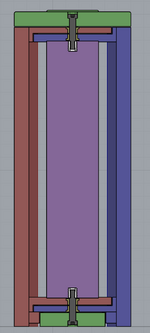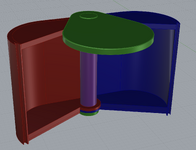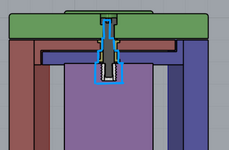Hello everyone, new to the site and am hopeful that I'll be able to receive some help. I'm not entirely sure my question has to do with mechanical engineering as I do not have any sort of engineering background, but it seemed like the right place to start. By trade I am actually a CNC operator working in furniture manufacturing, which finally leads me to my question. I am trying to design a object that firmly joins three separate components together but also allows for rotational movement around a center point. I am fairly proficient with the modeling software Rhino for those who are familiar with it and have been looking to McMaster Carr for all of the assembly's components. I will attach an image of what I have come up with so far. Essentially the red and blue components are to rotate around the shaft with some bearings that are house inside each of the components with the use of some washers/spaces to give everything a little clearance in the z-axis and fixed in place with some shaft collars. Initially the green component was to rotate freely around the shaft as well with a bearing housed inside but I am not thinking that I might like to have the green component fixed in place with the shaft directly connected to it and only the blue and red components rotate freely.
Again really not sure if this is the place for this question, it seems very basic but I've never had to design anything like this before and could really use some help. I am also genuinely interested in gaining further knowledge about these types of assemblies, utilizing parts sourced from mcmaster that allow objects to become more dynamic. So if anyone wanted to point me towards some resources to do that I would greatly appreciate it!
Thank you for your time!
Again really not sure if this is the place for this question, it seems very basic but I've never had to design anything like this before and could really use some help. I am also genuinely interested in gaining further knowledge about these types of assemblies, utilizing parts sourced from mcmaster that allow objects to become more dynamic. So if anyone wanted to point me towards some resources to do that I would greatly appreciate it!
Thank you for your time!










